#Whey Powder Market
Explore tagged Tumblr posts
Text
#whey powder market#whey powder market size#acid whey powder market#sweet whey powder market#whey powder market analysis#whey powder market forecast#whey powder market growth rate
0 notes
Text
Brazil Whey Market Share, Size, Trends, Revenue, Growth Strategy, Challenges, Business Opportunities and Forecast 2033: SPER Market Research
Whey protein is a high-quality protein that is separated from milk during the cheese-making process. It contains a lot of necessary amino acids, particularly BCAAs (branched-chain amino acids), which are important for the development and maintenance of muscle. Additionally, it has lactoferrin and immunoglobulins, which can strengthen the body's immune system. Due to its quick absorption and easy digestion, many people prefer using it as a supplement for post-workout recovery. It's well known for helping with weight management by encouraging sensations of fullness and supporting the maintenance of lean muscle mass. It can offer a ready-to-use supply of amino acids to build stronger muscles during exercise.
According to SPER market research, ‘Brazil Whey Protein Market Size- By Product Type, By Application- Regional Outlook, Competitive Strategies and Segment Forecast to 2033’ state that the Brazil Whey Protein Market is predicted to reach USD XX billion by 2033 with a CAGR of 8.24%.
The growing influence of e-commerce platforms, growing number of fitness centres, growing health and fitness consciousness, changing lifestyles, and sports nutrition are the main factors driving the Brazil whey protein market. Higher protein diets are becoming more popular among consumers as a way to promote weight loss, muscular growth, and general wellbeing. These dietary habits are well-suited for whey protein, which is well-known for its high-quality protein content. Further broadening the market's reach and accessibility is the development of e-commerce platforms, which make it simple for customers to obtain a range of whey protein brands and products. Furthermore, celebrity, fitness influencer, and athlete endorsements from Brazil increase the legitimacy of whey protein products and promote consumer uptake.
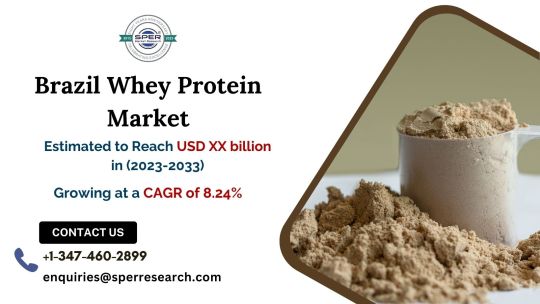
Growing consumer awareness of the benefits of eating a healthy diet and living an active lifestyle is driving the global demand for plant proteins. Furthermore, a huge market for plant proteins is being created by manufacturers' increasing advancements in producing proteins with a wide variety of amino acids and specific purposes, such as energy balancing, weight loss, muscle repair, and satiety. As a result, it immediately replaces animal protein products, impeding the expansion of the protein market. Plant-based proteins have gained a lot of popularity in recent years. A few examples of these include soy, pea, wheat, rice, algae, and hemp.
Request For Free Sample Report @ https://www.sperresearch.com/report-store/brazil-whey-protein-market.aspx?sample=1
The COVID-19 pandemic has a broad impact on the market for whey protein in Brazil. Early in the pandemic, people were looking to maintain their workout routines and boost their immune systems, which led to a spike in demand for health and wellness products, particularly whey protein. As a result, the industry's revenues briefly increased. But as the disease spread and the severity of the economic problems increased, many customers ran into financial difficulties, which reduced their discretionary purchasing. This thus reduced prospective customers' purchasing power and slowed demand for whey protein.
Brazil Whey Protein Market Key Players:
Due to its higher level of urbanization, which frequently equates to a greater knowledge and acceptance of fitness and health trends, South America has the greatest revenue share geographically. This region's urban lifestyle has increased demand for fitness-related items like whey protein and placed a higher priority on wellness. Furthermore, because of its economic importance and growing infrastructure, the South area frequently has access to a greater range of health and nutrition items as well as improved distribution networks. Furthermore, Arla Foods Ingredients, Carbery Group, Fonterra Co-Operative Group, Friesland Campina, and other significant firms are some of the market leaders.
For More Information, refer to below link:-
Brazil Whey Protein Market Future Scope
Related Reports:
Europe Sports Nutrition Market Size- By Product Type, By End User- Regional Outlook, Competitive Strategies and Segment Forecast to 2033
Ashwagandha Extract Market Size- By Application, By Distribution Channel, By Form, By Type- Regional Outlook, Competitive Strategies and Segment Forecast to 2033
Follow Us –
LinkedIn | Instagram | Facebook | Twitter
Contact Us:
Sara Lopes, Business Consultant – USA
SPER Market Research
+1-347-460-2899
#Brazil Booming Whey Protein Market#Brazil Natural Whey Protein Sales Market#Brazil Plant Protein Market#Brazil Sports Nutrition Market#Brazil Whey Market#Brazil Whey Protein Market#Brazil Whey Protein Market Challenges#Brazil Whey Protein Market Competition#Brazil Whey Protein Market Demand#Brazil Whey Protein Market Forecast#Brazil Whey Protein Market Future outlook#Brazil Whey Protein Market Growth#Brazil Whey Protein Market Opportunity#Brazil Whey Protein Market Overview#Brazil Whey Protein Market Price#Brazil Whey Protein Market Research Report#Brazil Whey Protein Market Revenue#Brazil Whey Protein Market Segmentation#Brazil Whey Protein Market Share#Brazil Whey Protein Market Size#Brazil Whey Protein Market Top Industry Players#Brazil Whey Protein Market Trends#Brazil Whey Protein Products Market#Lactalis Ingredients Brazil Whey Protein Market#Native Whey Protein Market#Natural Whey Protein Market#Organic Whey Protein Market#Pure Whey Protein Market#Whey Protein Concentrate Powder Market#Whey Protein in Brazil
0 notes
Text
Demineralized Whey Powder Ingredient Market Size, Share, Future Road-map, Technological Innovations & Growth Forecast To 2033
The demineralized whey powder ingredient market size is anticipated to surpass US$ 657 million in 2023 and is likely to attain a valuation of US$ 1,086.7 million by 2033. The demineralized whey powder market share is projected to thrive at a CAGR of 5% from 2023 to 2033.
Other health and wellness products, such as functional meals, dietary supplements, and sports nutrition, also contain demineralized whey powder. It has a low mineral content but is high in protein and lactose. The growing public’s interest in these goods and the related health advantages, such as muscle regeneration, weight control, and general nutritional support, is driving the market’s growth.
Stay ahead of the curve with our in-depth sample report on the Demineralized Whey Powder Ingredient Market. Access key market insights and stay informed about emerging trends! https://www.futuremarketinsights.com/reports/sample/rep-gb-1067
Demineralized whey powder has beneficial characteristics that enable it to be used in a variety of food and beverage industry applications. It serves as a protein, lactose, and flavoring source. Additionally, it is frequently used in food items as a stabilizer, bulking agent, or emulsifier. Demineralized whey powder’s functionality and adaptability generate demand for it in various industries, expanding the market.
Individuals with lactose intolerance have trouble digesting lactose, the natural sugar in milk and other dairy products. People who are lactose intolerant may use demineralized whey powder since it contains less lactose than conventional whey powder. The demand for lactose-reduced ingredients like demineralized whey powder is driven by the increasing recognition and diagnosis of lactose intolerance.
Consumers are becoming increasingly enamored with clean-label goods since they are regarded to be natural and minimally processed. Since demineralized whey powder is a pure milk by-product, it adheres to the clean-label trend. Since it is created by extracting minerals rather than employing chemical methods, it is also considered allergen-free. Demineralized whey powder sales are increasing due to consumer desire for clean-label and allergen-free products.
The market for demineralized whey powder is expanding as a result of the global dairy industry’s development and modernization. Whey processing technology and ingredient manufacturing capacities advance along with the dairy industry’s ongoing development. As a result, demineralized whey powder, a valuable by-product of the dairy industry, is more readily available and of higher quality.
Key Takeaways from the Demineralized Whey Powder Ingredient Market Report:
The global market size stood at US$ 631.47 million in 2022.
In 2022, the infant food segment captured 32.4% of global market shares.
The bakery and confectionary segment is expected to register a CAGR of 5.3% over the forecast period.
The United States captured 18.9% shares in the global market in 2022.
China captured 6.8% market shares in 2022.
India captured 9.8% of global market shares in 2022.
Recent Developments Observed by FMI:
FrieslandCampina Ingredients (Amersfoort, The Netherlands) debuted Deminal 90 Organic in June 2021 as a new organic version of their demineralized whey component for infant formula. It provides the right casein-to-whey ratio and restricts the mineral content. It is made using fresh milk from the company’s hand-selected network of organic dairy farmers.
Market Segmentation
By Product:
40% Demineralized Whey
50% Demineralized Whey
70% Demineralized Whey
90% Demineralized Whey
By Application:
Dietary Supplements
Bakery & Confectionery
Infant Food
Pharmaceutical
Others
By Region:
North America
Latin America
Europe
Asia Pacific
The Middle East & Africa (MEA)
Information Source: https://www.futuremarketinsights.com/reports/demineralized-whey-powder-ingredient-market
0 notes
Text
Whey Protein Market is Anticipated to Reach US$11.2 Bn by 2030 From US$5.3 Bn 2021
“Global whey protein market is on the brink of remarkable growth, with a current valuation of nearly US$5.3 Bn in 2021, projected to skyrocket to US$11.2 Bn by the end of 2030. Boasting a steady growth outlook, the market is set to experience a notable CAGR of 8.6% during 2022 - 2030, signalling a promising future ahead.”
A global rise in the number of healthcare centres and fitness centre establishments are enabling a coalition of sports and nutrition. Consequently, whey, and casein have become essential dairy proteins in sports nutrition products. Such trends across the sports and nutrition space are carving the dimensions of the global whey protein market. Pervasive hard-core fitness regimes, and strict diet plans among sports individuals are aligning with the need for protein-based nutrition and convenience products.
Comprising essential amino acids that cannot be produced by the human body itself, whey protein has been instrumental in building and repairing muscle tissue whilst maintaining the overall health of individuals. Serving as a protein supplement, intake of whey protein significantly brings down cholesterol levels and promotes muscle protein synthesis, weight loss, and lean muscle mass growth. These and more such perceived benefits drive the growth of whey protein market space.
For More Industry Insights Read: https://www.fairfieldmarketresearch.com/report/whey-protein-market
Innovative Sports Nutrition Products Drive Market Growth
The athletics industry is making remarkable contributions to the global whey protein market valuation. In response to the rising demand for sports nutrition products, manufacturers in the domain are now prioritising the development of innovative whey protein products that can meet the diverse needs and preferences of consumers seeking different types of benefits. Various shoppers are attracted to protein-rich products, clearly due to diverse health benefits aiding muscle formation and recovery process.
Similarly, whey protein also tends to facilitate reduction of appetite, and retards age-related loss of muscles. Addressing these trends, manufacturers, including Axiom Foods, Inc, A&B Ingredients, Ingredion Incorporated, Roquette Frères, Puris, Emsland Group, DuPont, Glanbia plc, Scoular Company, and Fenchem, are highly ambitious to deliver products enriched with vital dairy proteins and essential and nonessential amino acids.
Market Benefits from Growing Consumer Interest in Healthier Whey Snacks
Past years have been decisive in spurring shifts in food consumption and increased demand for whey protein. A proactive dietary approach undertaken by well-informed consumers has been imperative to realising holistic health goals. Nonetheless, a perfect blend of taste, texture, and health is at the core of consumer diet plans.
Intake of whey powder can enhance the working of the immune system, promote gut health and maintain overall health. It is in strong concurrence with the fact that whey snacks have become popular among health-driven individuals. To this end, dry whey protein has garnered 90% of overall demand, whereas 40% of the whey protein market share remains in favor of whey protein concentrates.
Asia Pacific Turns Lucrative with Consistent Growth in Demand
North America’s lead in the global whey protein market prevails with more than 30% share in overall valuation. The market here will continue to enjoy the first-mover’s advantage throughout the period of projection, states the report. Europe is the second leading market presenting ample opportunity to whey protein manufacturers.
Asia Pacific is also reportedly generating robust demand and consistent product launches for nutraceuticals, precipitating substantial growth opportunities for the regional market. Several health-related ailments, including IBD and obesity, have cropped up due to changing lifestyles, busier schedules, and unhealthy habits among consumers. Amid growing health concerns, a propensity to consume healthy food and adopt healthier lifestyles has scaled at pace. Moreover, soaring demand from medical, sports, and personal care industries is strengthening China’s, and India’s stand in the global market.
Get a PDF Sample Copy of Whey Protein Market at https://www.fairfieldmarketresearch.com/report/whey-protein-market/request-sample
About Us
Fairfield Market Research is a UK-based market research provider. Fairfield offers a wide spectrum of services, ranging from customized reports to consulting solutions. With a strong European footprint, Fairfield operates globally and helps businesses navigate through business cycles, with quick responses and multi-pronged approaches. The company values an eye for insightful take on global matters, ably backed by a team of exceptionally experienced researchers. With a strong repository of syndicated market research reports that are continuously published & updated to ensure the ever-changing needs of customers are met with absolute promptness.
#whey protein market#whey protein#whey protein market share#whey protein market size#whey protein market growth#whey protein market demand#whey protein market research#dietary supplements#protein concentrate#whey protein powder#fairfield market research
0 notes
Text
listen it's absolutely ESSENTIAL to the gym bro au that we all understand the difference between preworkout, protein, and creatine
preworkout: literally caffeinated powder. half the time it looks like cocaine. on friday one of my students said he took two scoops of preworkout "just cuz" and when i was like "wtf are you insane" he just shrugged and was like "ya but i was so locked in i had the best workout of my life" honestly idk how he's alive. i hc that this is the only thing danny likes about the gym and gym culture
protein: what muscles are made of!! gym bro ppl usually consume 0.7g per pound of bodyweight for optimal muscle growth. irl the most popular brand of whey protein powder on the market rn is no joke called ghost. danny thinks this is very funny.
creatine: 3 essential amino acids for supplying energy to the muscles and is used for recovery and muscle growth. supplements can be taken in either pill or powder form. dash always offers danny some creatine right after their workouts together and danny always turns him down because it's just one step too far down the gym bro rabbit hole and he's not mentally and emotionally ready for that yet. also kid barely passed biology with a D he doesn't know what the hell an amino acid is.
120 notes
·
View notes
Text
The study tested 160 products from 70 top protein powder brands, though neither the products nor brands were named in the report. The sample pool represented 83% of the market, the report read.
Protein powders made from plants like rice, peas or soy have been found to contain triple the amount of lead compared to products made from whey, the liquid byproduct of cheese, the report finds.
The report suggests the contamination could come from harmful agricultural practices — like some pesticides and fertilizers — as well as packaging or environmental exposure. Heavy metals are naturally occurring in the Earth's crust, CNN reported — which plants then absorb.
Furthermore, chocolate flavoring significantly contributes to toxicity levels, the report found. Though dark chocolate has been proven to have an array of health benefits, it also has been found to have high levels of heavy metals, according to a study conducted in July 2024.
“Chocolate-flavored protein powders contained four times more lead and up to 110 times more cadmium than vanilla-flavored powders,” said JaclynBowen, executive director of the Clean Label Project.
4 notes
·
View notes
Text
Old Person Rant:
I want to apologize to the kids today who are growing up in the misinformation era. I truly hope your generation learns to differentiate the honest from the cozen.
Anyways today I ended up buying a buncha this shit because I like yogurt, I love protein and I love cherries. I figured they added whey powder to cherry yogurt.
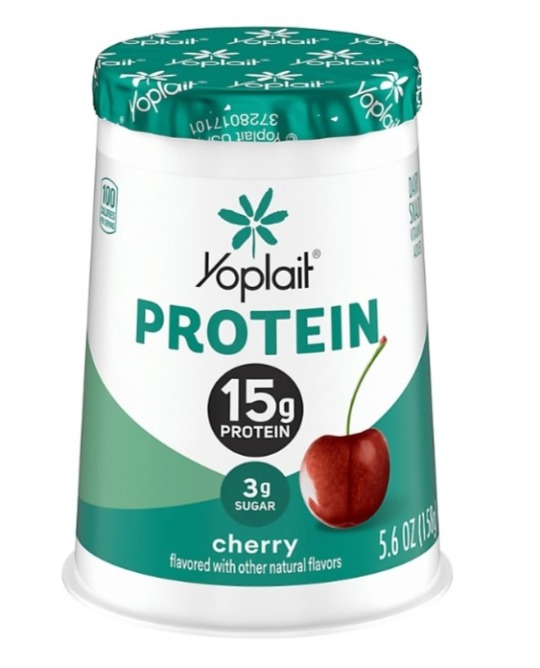
Mean ol' bitch rant under the cut

Nope. Not a single cherry in the ingredients list. It's sweetened with Sucralose which is an artificial sweetener that makes me gag. So instead of cherry flavor, I get "Rather be giving a blowie" flavor.
Nowhere on this bitch does it say sugarfree.
Nowhere on this bitch does it say "Does not contain cherries."
The texture kinda sucks too but I was expecting that - with 15g protein and 100 calories I expecting that (even though it doesn't say non-fat anywhere on it, I can do the math and figure there's no-to-low-fat at 100 cals.)

How the fuck are you claiming that there are no artificial flavors when 1) CHERRY IS NOT IN THE INGREDIENTS LIST FOR A FUCKING CHERRY YOGURT AND 2) Sucralose is literally an artificial flavor.
And don't get me started on using BEET. JUICE. Just use a fucking cherry. Using beet juice (for color) is LITERALLY THE DEFINITION of an artificial color when you're advertising the bullshit with a PHOTO OF A FUCKIN CHERRY ON THE FRONT. Just because you didn't use Red 40 does not mean this isn't an act of pure fucking artifice.
I hate products today, man. I fucking hate em. I hate shopping online, I hate shopping in stores, I hate being offered bullshit that has ZERO ACTUAL VALUE that's put in a pretty package with a buncha lies in fine print and sold as if it's something else.
I hate that nothing on the shelf today can be taken at face value because of the big fuckin' hardon that General Mills has for duping people into overpaying for shit that they couldn't GIVE AWAY unless they FORCE the real thing to be unavailable.
If I could give every kid a magic schoolbus trip to go grocery shopping in other countries, and even in the USA but in earlier decades, I would.
My trust in these products are so broken that I even wonder if there's ACTUALLY 15g of protein in this cup or if that math is just a creative interpretation as well.
Sorry kids. I wish we had done better at nipping deceptive marketing in the bud, but there's no consequences for these types of practice. I'm only hoping if you're seeing these products on the shelf that you get critical, and don't buy them if
1) There's too much print on the package and it ain't worth my time to read. [Fewer words means fewer ingredients and less bullshit.]
2) The package doesn't give you full confidence that the product inside is actually the thing that you want or need.
Not buying the shit at all is the only way to get it off the shelf. I'm sorry I bought as many of these as I did and I'll probably be taking the rest to a Free Fridge. At least that way the homeless will know not to let GM give this shit to them and claim it as a tax writeoff.
8 notes
·
View notes
Text
Top Gut Health Supplements for a Balanced Digestive System

Gut health is also essential and the most critical factor in recognizing an individual's health. Gut health supplements are vital for overall well-being. A healthy gut helps digestion, allowing the body to absorb nutrients efficiently. It also supports the immune system, protecting against infections and diseases. Good gut health can improve mood and mental health, as the gut is connected to the brain through the gut-brain axis. Eating a balanced diet of fiber, fruits, vegetables, and probiotics can promote a healthy gut. Avoiding excessive sugar and processed foods also helps. Maintaining gut health is critical to feeling energetic and healthy every day, and it can be done by using the Treownut gut health supplements.
Also Read - plant based protein powder india
Treownut has a wide range of plant-based supplements that have countless health benefits. There are three types of plant protein available at Treownut: Soy protein, Whey protein, and Pea protein. You can choose according to your preferences which is best suited for you. Treownut is a one-stop store for all your supplement needs. Along with protein supplements, Treownut also has a range of skin and hair vitamins, which are very beneficial. As we all know, vitamins are a crucial part of the diet that cannot be skipped. These vitamin supplements are all-natural and don't contain any artificial preservatives. The hair and skin supplements are in the form of tablets, which can be quickly taken during the course.
Must Read- hair vitamins for thicker hair
Why Choose Treownut?
Convenience of Supplement Online Shopping: At Treownut, you can easily buy supplements online from your home. Our user-friendly website ensures a seamless shopping experience.
Wide Range of Products: Whether you are looking for plant-based protein such as pea, whey, or soya protein or specific health supplements like hair and skin vitamins, Treownut has got you covered.
Trusted Online Supplement Store India: As a leading online supplement shop in India, we prioritize quality and customer satisfaction. All our products are sourced from reputable manufacturers and undergo rigorous quality checks.
Best Online Shop for Supplements: Treownut is recognized as the best online shop for supplements due to our extensive product range, competitive prices, and exceptional customer service.
Health Supplements for Every Need: We offer a variety of health supplements to cater to different health goals. From muscle building and weight management to hair and skin care, Treownut is your go-to online supplement store.
Read Also - best medicine for constipation in india
Benefits of Shopping with Treownut
Supplement Online Shopping India: Treownut is tailored to the Indian market, providing local support and faster delivery times.
Buy Supplements with Ease: Our website is designed to help you find and buy supplements that suit your needs.
Best Site to Buy Supplements in India: We are the best site to buy supplements in India, thanks to our comprehensive product selection and customer-centric policies.
Fitness is essential for everyone as health is a significant aspect of human life, whether it's related to gut health supplements or supplements for glowing skin. We provide the best supplements for your fitness goals, such as a healthy gut, skin, and hair. People these days are eager for health and do many things to keep themselves healthy and maintain a good healthy lifestyle. There are different kinds of supplements that people use to preserve the protein in the body. Supplements are beneficial for the health of their nature as chemical supplements also harm the body's natural immune system. Certain people get the trap of chemical supplements, ending up ruining the natural barriers of the body that protect them. The best protein and gut health supplements are made up of natural ingredients.
For more read our blog - https://seo2jgservices.wixsite.com/jgservices/post/discover-the-best-health-supplement-brand-in-india-treownut
2 notes
·
View notes
Text
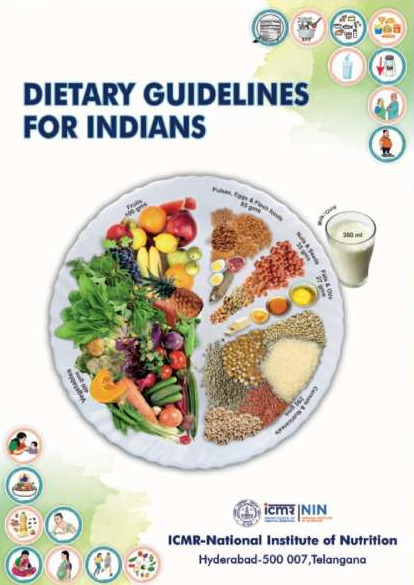
ICMR NUTRITION GUIDELINES 2024 BREAKDOWN : LSFITNESS
Statement 1 : Some protein powders, marketed in packages as protein supplements, contain protein from multiple sources. Protein powders may also contain added sugars, non-caloric sweeteners and additives such as artificial flavoring, hence, are not advisable to be consumed on a regular basis.
My Take: Protein powders that contain proteins from multiple sources are known as protein blends. These blends often include whey protein, casein protein, albumin, and others. Protein blends are completely safe for use if they are manufactured and processed in facilities that adhere to strict safety standards, such as those following HACCP (Hazard Analysis and Critical Control Points) guidelines.
Statement 2 : Protein powders may also contain added sugars, non-caloric sweeteners and additives such as artificial flavoring, hence, are not advisable to be consumed on a regular basis.
My Take: Protein powders may contain added sugars, non-caloric sweeteners, and artificial flavorings. However, these additives are commonplace in many foods we consume today. Rather than casting a negative light on whey protein supplements, it would be more beneficial to implement strict regulations that limit the use of added sugars. Additionally, encouraging the use of healthier non-caloric sweeteners, such as Fructo-oligosaccharides (FOS), and replacing artificial flavorings with natural ones could improve the nutritional quality of these supplements.
Statement 3 : Whey protein is rich in branched chain amino acids (BCAAs). Recent evidence suggests that BCAAs may increase the risk of certain non-communicable diseases (NCDs). As mentioned above, adequate non-protein energy from carbohydrate and fat is essential for dietary proteins/AA to be utilized for protein synthesis and for related functions in the body. Consuming high level of protein, especially in the form of protein supplement powders, is therefore not advisable.
My Take: Whey protein is indeed rich in branched-chain amino acids (BCAAs): leucine, isoleucine, and valine. Recent evidence has shown a direct correlation between elevated plasma levels of BCAAs and insulin resistance, but this does not necessarily mean it is caused solely by high consumption of BCAAs. The condition may also be due to dysfunctional BCAA catabolism, existing insulin resistance, or being overweight or obese.
Elevated plasma BCAA levels have been observed in individuals who are overweight or obese and exhibit insulin resistance, and these levels are higher compared to healthy individuals. Observational studies have found that plasma BCAA levels are also elevated in patients with Type 2 diabetes when compared to age and BMI-matched controls without diabetes.
Insulin plays a critical role in the metabolism of BCAAs. Results from Mendelian randomization studies indicate that insulin resistance drives higher plasma BCAA levels, and large-scale genetic studies suggest a causal role of diminished BCAA catabolism in underlying insulin resistance.
Dysfunctional BCAA catabolism may lead to the accumulation of a number of BCAA catabolic metabolites in the plasma of insulin-resistant individuals with obesity or Type 2 diabetes, including BCAA-derived acylcarnitines, 3-HIB, 2-HB, and 2-KB. These can have toxic effects on cellular functions. It has been shown that acylcarnitines can cause mitochondrial dysfunction in several tissues and anaplerotic stress, thus dysregulating glucose and fat oxidation.
While there is evidence that elevated BCAA levels can impair insulin signaling pathways, it remains unclear whether elevated BCAA levels are a cause or a consequence of insulin resistance. Most studies measure plasma BCAA levels rather than in peripheral tissues, so future research focusing on peripheral tissues could provide a better perspective on tissue-specific BCAA catabolism.
Statement 4 : Most athletes can get the recommended amount of protein through food alone, without the use of supplements. Protein powders are not required. Moreover, prolonged intake of a large amount of protein is associated with potential dangers, such as bone mineral loss and kidney damage.
My Take: Athletes can obtain the recommended amount of protein through their diet alone, depending on what they eat.
For example, a non-vegetarian athlete can easily meet protein needs from sources such as chicken breast, mutton, and whole eggs while maintaining overall caloric intake, as these sources contain fewer ancillary calories.
Conversely, let's consider an athlete who follows a vegan diet. Major vegan protein sources like tofu, cereals and millets, and pulses and legumes do provide some protein. However, if an athlete relies solely on these foods without supplements, the total calorie count may exceed caloric requirements due to the additional carbohydrates and fats in these protein sources.
Regarding the safety of protein consumption, prolonged intake of a significant amount of protein—ranging from 25-75 grams daily—has not been associated with potential dangers such as bone mineral loss and kidney damage. In fact, studies have shown a positive impact on bone mineral density.
The European Society on Parenteral and Enteral Nutrition (ESPEN) advocates for a higher protein intake of 1.0–1.5 g/kg/day to help slow age-related muscle loss.
There is no evidence to suggest that a high protein diet can cause kidney damage in individuals with healthy renal function. However, those with kidney disease, such as chronic kidney disease (CKD), should limit their protein intake.
3 notes
·
View notes
Text
Are Canada's food labeling laws really lax? @thetabirb 's mom brought us a variety of these "hot chocolates"
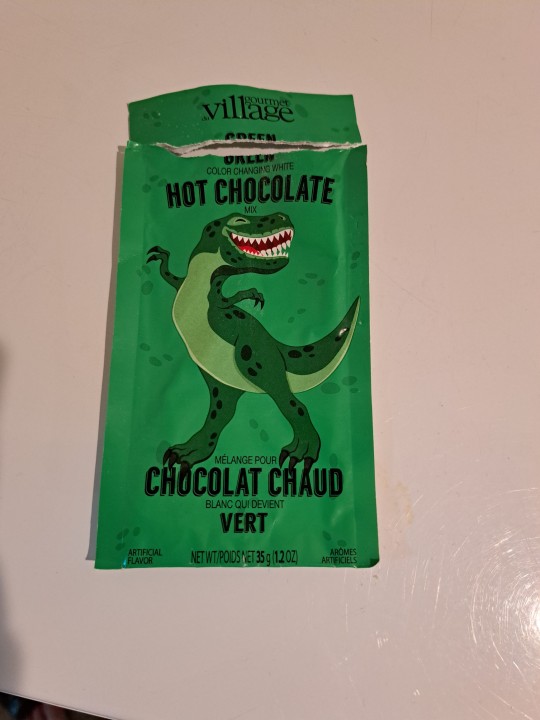
[Image Description: a torn and empty packet of drink mix. The packet is green, with a cartoony dancing green T-Rex. The torn top is branded "Gourmet Village", and the packet is labeled "Green Color Changing White Hot Chocolate Mix", with it repeated on the bottom in French ("Mélange Pour Chocolat Chaud Blanc Qui Devient Vert"). In the bottom corners it says in tiny letters "Artificial flavor/Aromes Artefciels". End I.D]
from the northern border but the interesting thing is, uh
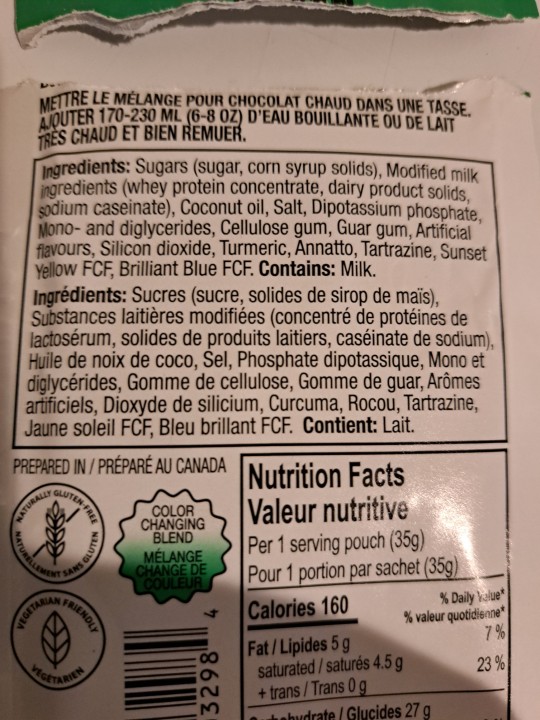
[Image Description: the white back of the packet, showing the ingredients (and two seals, one declaring it gluten free and the other declaring it vegetarian). The ingredients are: sugars (sugar, corn syrup solids), modified milk ingredients (whey protein concentrate, dairy product solids), coconut oil, salt, dipotassium phosphate, mono- and diglycerides, cellulose gum, guar gum, artificial flavours, silicon dioxide, turmeric, annatto, tartrazine, Sunset Yellow FCF, Brilliant Blue FCF. Contains: Milk". Beneath that the ingredients are repeated in French. End I.D]
There's no actual chocolate in it. And not even in a white chocolate way, where there's cocoa butter but no cocoa powder and cocoa solids. There's no cocoa anything, meaning it's not chocolate. Which works for me because cocoa powder and solids give me vomiting migraines (the cocoa butter in white chocolate is fine), and it bypasses the ethics of supporting the consumption of slave-made chocolate, but. I'm baffled
In the U.S this would have to be called something like "chok'lit drink" or something. It's why we have "cheez" or "kreme", because they can't legally be called cheese or cream given their ingredients and/or formulation, or vegan foods are called "chik'n" and the like. There's even a push by the dairy industry to ban the marketing and calling of calling plant-based milk, "milk". And I know the E.U is even more anal about food designations. Theta and I were in disbelief that it didn't have any cocoa anything in it last night. Out of six different packets, only one of them had actual cocoa product in it.
(Also I drank my "hot chocolate" already, but one thing it was honest about was that it actually did turn my milk green.)
5 notes
·
View notes
Text
Happy Healthy Cows: The Secret Behind the Purest Raw Grass Fed Whey Protein

As a health-conscious consumer looking for the best protein supplements, I recently had the opportunity to try out the Raw Grass Fed Whey by Happy Healthy Cows. With a focus on sustainable and ethical practices, this product promises to deliver high-quality whey protein sourced from grass-fed cows. In this review, I'll be sharing my experience with this product, highlighting its taste, texture, nutritional profile, and overall effectiveness as a protein supplement.
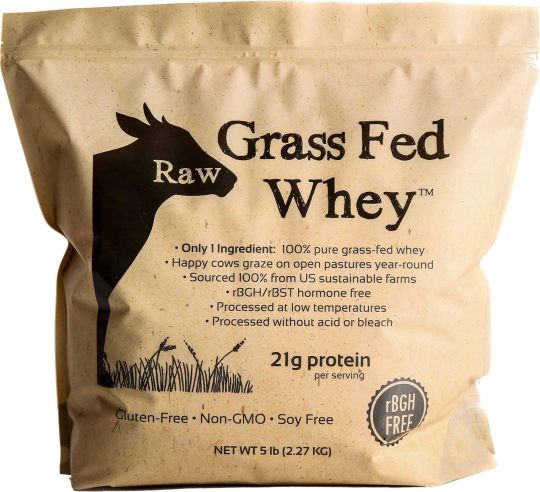
Taste and Texture: One of the first aspects that caught my attention was the smooth and creamy texture of the Raw Grass Fed Whey. Unlike some other protein supplements on the market, this one mixed effortlessly with both water and milk, leaving behind no clumps or gritty residue. As for the taste, I was pleasantly surprised by the natural and mild flavor of the whey. It lacked the artificial sweetness commonly found in other protein powders, making it more enjoyable to drink without overwhelming my taste buds.
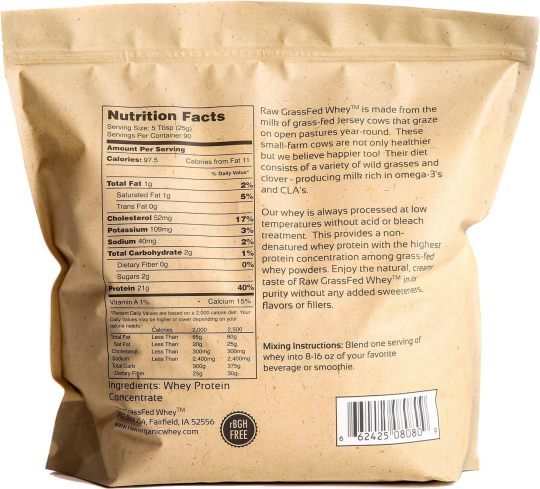
Nutritional Profile: Raw Grass Fed Whey boasts an impressive nutritional profile, especially for those seeking clean and pure protein sources. As the name suggests, it is sourced from grass-fed cows, which means it contains higher levels of omega-3 fatty acids, conjugated linoleic acid (CLA), and essential nutrients. Additionally, it is free from artificial hormones, antibiotics, and genetically modified organisms (GMOs), ensuring a healthier and more natural protein option.
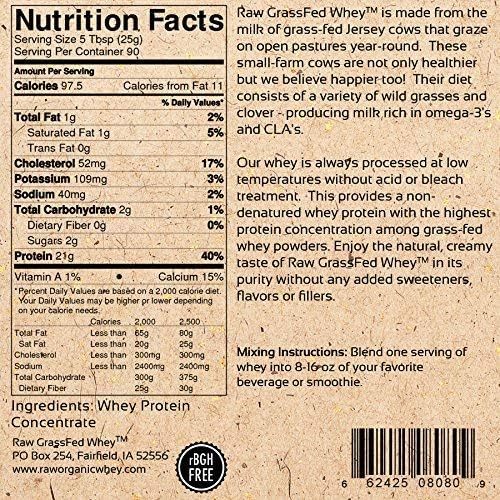
Effectiveness: I incorporated the Raw Grass Fed Whey into my post-workout routine, and I noticed a significant improvement in my muscle recovery and overall performance. The high protein content per serving, coupled with its excellent amino acid profile, undoubtedly contributed to the positive results I experienced. I also felt that the protein helped me maintain satiety between meals, making it a valuable addition to my diet, particularly during busy days.
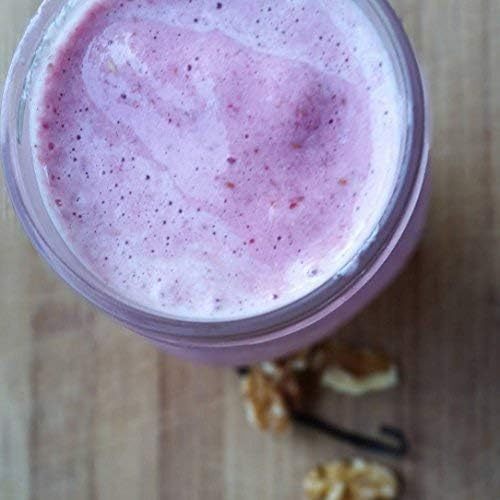
Ethical Considerations: Happy Healthy Cows' commitment to ethical practices and sustainable sourcing is a notable advantage. Knowing that the whey comes from cows that are raised humanely, without exposure to harmful chemicals or confined living conditions, gives me peace of mind as a conscious consumer. Supporting a brand that prioritizes animal welfare and environmental responsibility adds to the product's appeal.
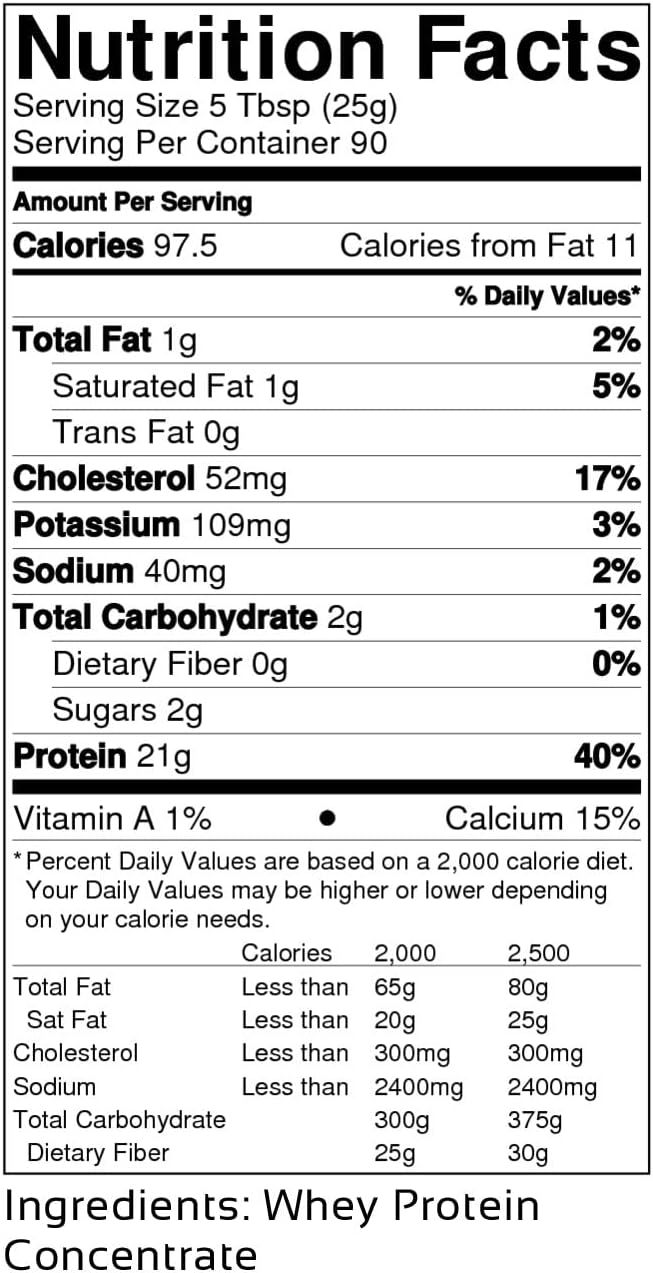
Price and Value: While Raw Grass Fed Whey is priced slightly higher than some mainstream protein supplements, the quality, purity, and ethical standards justify the cost. Considering its effectiveness and nutritional benefits, I believe it offers good value for the price, especially for those who prioritize quality over quantity.
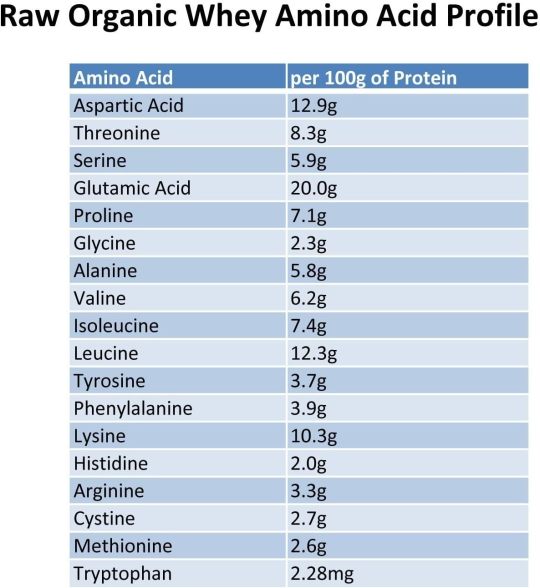
Conclusion: Overall, I am highly impressed with Raw Grass Fed Whey by Happy Healthy Cows. Its smooth texture, pleasant taste, and superior nutritional profile make it an excellent choice for fitness enthusiasts, athletes, and health-conscious individuals. Additionally, the brand's commitment to sustainability and ethical practices is commendable and sets it apart from many other protein supplements on the market. If you are looking for a top-notch grass-fed whey protein option, I would highly recommend giving this product a try.
#healthy#life#beauty#whey protein#fitness#superfoods#shakes#diet#muscle#exercise#mindfulness#millionaire#mindset
1 note
·
View note
Text
Unveiling Growth Trends: Whey Protein Powder Market Insights 2023-2030
The Whey Protein Powder Market has experienced steady growth in recent years, with expectations to maintain this positive progression until 2030. Notably, a key trend shaping this market is the increasing preference for sustainable and eco-friendly products. Another significant aspect is the integration of technology to enhance product quality and efficiency, with cutting-edge technologies such as artificial intelligence, machine learning, and blockchain being leveraged for innovation.
Market Overview and Growth Opportunities
The Whey Protein Powder Market Research Report projects a promising future for the industry, offering insights into size, share, scope, growth, and potential. The article suggests that the Whey Protein Powder market is poised for continued expansion, driven by the growing demand for sustainable and innovative products and the widespread adoption of technology.

Key Players and Market Dynamics
The report identifies key players in the Whey Protein Powder market, including Yukon Advanced Optics, Orpha, Bushnell, ATN, Armasight, Starlight, LUNA OPTICS, Firefield, Night Owl Optics, Apresys, Shenzhen Ronger, Yunnan Yunao, Bosma, ROE, among others. These companies have the potential to drive market growth through various strategies, such as offering innovative products, expanding distribution channels, and forming strategic partnerships.
Market Segmentation and Forecast
The global Whey Protein Powder market size is segmented based on application, end-user, and region. The report forecasts that by 2030, the market size will reach multimillion figures, displaying an unexpected compound annual growth rate compared to figures observed in 2021. The study emphasizes the analysis of different factors influencing the industry's growth and provides a detailed scope of various segments and applications that can potentially influence the market in the future.
Infrared Night-Vision Scope Market Analysis
The report also delves into the Infrared Night-Vision Scope market, estimating its worth to be USD 243.2 million in 2022 and projecting a readjusted size of USD 292.6 million by 2030, with a CAGR of 3.1 percent during the forecast period 2023-2030. The market is influenced by factors such as the COVID-19 pandemic and the Russia-Ukraine conflict, contributing to economic changes and altering market dynamics.

Global Trends and Drivers
The research report analyzes trends, restraints, and drivers shaping the Whey Protein Powder market. The growing consumer awareness of health and wellness is identified as a significant driver, leading to increased demand for healthier and more natural alternatives. Furthermore, technological advancements within the industry, including more efficient and sustainable production methods, are propelling market growth.
Market Outlook 2023-2030
From 2023 to 2030, the Whey Protein Powder market is expected to display consistent and positive growth, driven by increasing consumer demand, technological advancements, and shifting consumer preferences. The outlook is optimistic, with sustained growth anticipated, and the industry is poised to witness innovation fueled by substantial investments from key players.
Impact of External Factors
The Whey Protein Powder market is anticipated to be significantly influenced by external factors such as the Russia-Ukraine war and the post-COVID-19 pandemic. These factors have created political and economic instability, impacting consumer purchasing power. However, Whey Protein Powder remains essential, and as the situation stabilizes, there is an expected rebound in demand. In conclusion, the Whey Protein Powder market is on a trajectory of sustained growth, driven by consumer preferences, technological advancements, and strategic investments. The industry's resilience is expected to overcome challenges posed by external factors, and the market outlook remains optimistic.
#Whey Powder Market#Whey Powder Industry#Whey Powder Market Revenue#Whey Powder Market Growth Rate#Whey Powder Market Future Outlook#Whey Powder Market Analysis#Whey Powder Market Size#Whey Powder Market Share
0 notes
Text
Buy Annex Zero Vanilla Protein Powder | Complete Nutrition
ANNEX ZERO
Zero Fillers, Zero blends, Zero compromise! Elite Gold VIP Series does not conform to the standards of typical Sports Nutrition products that load their products up with confusing blend names and heaps of maltodextrin.
Vanilla protein powder is 100% pure whey protein isolate, increased muscle recovery, clinically proven ingredients. Zero fillers, zero blends, zero compromises!
RAPID ABSORPTION
MUSCLE RECOVERY
ZERO FILLERS
100% PURE WHEY PROTEIN ISOLATE: Made from the fastest digesting protein on the market with the highest uptake ratio and zero fillers and zero blends, making it the purest and most bio-available form of whey protein.
INCREASED STRENGTH & MUSCLE RECOVERY: Maximize muscle growth with Elite Gold VIP Series Annex Zero Whey Protein which delivers 23g protein and over 5g BCAAs per serving to lead to maximized muscle recovery and growth.
CLINICALLY PROVEN INGREDIENTS: Formulated with digestive enzymes like protease and lactase which assist in the breakdown of protein, peptides, and lactose making this whey Vanilla protein powder very easy to digest resulting in enhanced recovery. Full label transparency and third-party tested.
#diet#completenutrition#dietary supplement#health supplement#nutrition#health#growth#protein shake#supplements
1 note
·
View note
Text

United States Whey Protein Market Share and Growth Report, 2031
The United States Whey Protein market is projected to witness a CAGR of 4.8% during the forecast period 2024-2031. It was estimated at USD 1.06 billion in 2023 and is expected to reach USD 1.54 billion in 2031. Whey protein, derived from milk during the cheese-making process, has gained immense popularity due to its high-quality protein content and potential health benefits. The market assessment reveals several key trends and factors shaping its growth.
Click here for full report- https://www.marketsandata.com/industry-reports/united-states-whey-protein-market
Growing Health Awareness Driving Whey Protein Market Expansion
The increasing health consciousness among consumers is a key driver of the whey protein market. As more individuals prioritize fitness, they seek convenient and effective protein sources to support muscle growth, weight management, and overall well-being. This has fueled demand for whey protein in various forms, including powders, bars, and ready-to-drink (RTD) shakes.
The sports nutrition sector also plays a significant role in market growth. Athletes, bodybuilders, and fitness enthusiasts rely on whey protein’s rapid absorption to aid in post-workout recovery and muscle development. As a result, specialized formulations have been introduced to cater to diverse performance needs.
Product innovation is another major factor influencing the market. Manufacturers are focusing on flavor variety, ingredient transparency, and functional additives such as probiotics, enzymes, and plant-based alternatives. These innovations expand the consumer base beyond traditional dairy consumers to include those looking for alternative protein sources.
However, the market faces challenges such as rising competition and the growing popularity of plant-based proteins, which attract vegan and environmentally conscious consumers. Additionally, regulatory oversight regarding label claims, nutritional accuracy, and quality standards continues to shape industry dynamics.
Addressing Obesity and Weight Management
With rising obesity rates and an increasing focus on healthier lifestyles, whey protein is becoming a key tool for weight management. According to World Population Review 2023, the United States ranks among the top 15 countries with the highest obesity rates, with 36.2% of adults classified as obese. As obesity remains a major health concern, more individuals are turning to sustainable dietary strategies that help control calorie intake and improve body composition.
Whey protein, known for its high protein content, low carbohydrates, and moderate calorie profile, has become a preferred option. Marketing campaigns emphasizing whey protein’s role in boosting metabolism, maintaining muscle mass, and supporting energy expenditure have resonated with health-conscious consumers. As awareness grows, whey protein is expected to remain integral to the nation’s broader efforts to combat obesity and promote healthier living.
The Rise of Ready-To-Drink (RTD) Whey Protein
The ready-to-drink (RTD) trend is significantly driving whey protein market expansion in the U.S. The demand for convenient, on-the-go nutrition has boosted the popularity of RTD whey protein beverages, catering to busy individuals who require easily accessible, high-quality protein sources.
With increasing emphasis on fitness, wellness, and time efficiency, RTD whey protein products align with consumer preferences for nutritional convenience. This growing demand has led to increased product innovation.
For example, in September 2022, Nestlé, the world’s largest food and beverage company, announced plans to develop a ready-to-drink protein beverage using cultivated whey, free from animal ingredients. This initiative was part of Nestlé’s exploration into precision fermentation technology, with plans to trial the product in the U.S. the same year.
Growing Sports and Fitness Enthusiasm Boosting Market Growth
The rising number of sports and fitness enthusiasts is a crucial factor fueling the U.S. whey protein market. As more individuals engage in physical activity and athletic performance enhancement, demand for high-quality protein sources has surged.
Whey protein is particularly valued for its rapid absorption and complete amino acid profile, making it an ideal choice for muscle recovery and growth. Athletes, bodybuilders, and fitness-conscious consumers increasingly incorporate whey protein into their post-workout routines to enhance muscle repair and performance.
In July 2022, Myprotein collaborated with Perfect Day to launch Whey Forward, an innovative animal-free whey protein powder. Developed using precision fermentation technology, this product replicates whey protein using microorganisms rather than animal sources. Available in three flavors—mint chocolate chip, chocolate brownie, and salted caramel—Whey Forward offers a sustainable alternative for protein supplementation.
Download Sample Report
Increasing Consumer Awareness of High-Protein Diets
Growing awareness of the importance of high-protein nutrition is another factor propelling the whey protein market. As consumers become more informed about nutrition and wellness, the demand for protein-rich products continues to rise.
Protein is recognized for its crucial role in muscle maintenance, weight management, and overall health. This heightened awareness has led to a continuous expansion of the whey protein market, as it aligns with the increasing demand for nutrient-dense foods.
For instance, in August 2022, Arla Foods Ingredients (AFI) introduced a plug-and-play protein solution designed for snack manufacturers. This innovation enables the production of high-protein bars with enhanced protein content across all layers—mass, filling, and coating—while maintaining flavor and texture throughout the product’s shelf life.
Impact of COVID-19 on the Whey Protein Market
The COVID-19 pandemic had a mixed impact on the U.S. whey protein market. Initially, supply chain disruptions led to fluctuations in product availability and price increases. Additionally, gym closures and lifestyle changes caused a temporary decline in protein supplement usage.
However, the pandemic also accelerated the focus on health and wellness, increasing demand for at-home fitness solutions. Consumers sought immune-boosting and muscle-supporting nutrients, leading to a resurgence in whey protein sales.
Moreover, the pandemic drove a shift toward e-commerce, making whey protein products more accessible through online platforms. Despite initial challenges, the market adapted to changing consumer behaviors, reinforcing whey protein’s role in health-conscious lifestyles.
Market Outlook and Report Scope
The “United States Whey Protein Market Assessment, Opportunities, and Forecast (2017-2031F)” by Markets and Data provides a comprehensive analysis of the current market landscape, industry trends, and future projections. Covering market size, growth drivers, challenges, and competitive intelligence, the report also profiles leading industry players and their business strategies.
Latest reports-
Contact
Mr. Vivek Gupta 5741 Cleveland street, Suite 120, VA beach, VA, USA 23462 Tel: +1 (757) 343–3258 Email: [email protected] Website: https://www.marketsandata.com
0 notes
Text
How Heavy Metals in Whey Protein Could Be Harming Your Health!
As fitness enthusiasts, we are constantly looking for ways to enhance our workout results, boost muscle growth, and recover faster. Whey protein supplements have become a go-to solution for anyone looking to meet their daily protein requirements. Among the various options, Isolate Whey Protein has gained significant popularity due to its high protein content and low fat and carbohydrate content. However, recent studies have raised concerns about the presence of hidden heavy metals in many protein powders, potentially putting your health at risk. Are you unknowingly consuming dangerous toxins with every scoop of protein? Let's dive deeper into this issue and uncover the hidden heavy metal threat in protein supplements.

What Are Heavy Metals and Why Are They Dangerous?
Heavy metals are a group of elements that can be toxic even in small quantities. Some of the most common heavy metals found in protein supplements include:
Lead
Arsenic
Cadmium
Mercury
These metals are naturally occurring in the environment, but industrial pollution, soil contamination, and poor manufacturing practices can introduce them into food products, including protein powders.
Exposure to heavy metals can have serious health consequences. Long-term exposure, even at low levels, can lead to a variety of health issues, including:
Kidney damage
Neurological problems
Hormone disruption
An increased risk of cancer
For individuals who consume protein supplements regularly, the risk of accumulating these toxic metals over time becomes a serious concern.
How Do Heavy Metals End Up in Protein Supplements?
The presence of heavy metals in protein supplements is often the result of contaminated raw materials. Whey protein is derived from milk during the cheese-making process, and if the cows are exposed to contaminated feed, water, or soil, the heavy metals can end up in the whey protein. Similarly, plant-based proteins can also be contaminated if the plants absorb toxins from the soil.
Manufacturers sometimes neglect proper testing for heavy metals or fail to follow rigorous safety protocols during production, leading to products with higher-than-acceptable levels of toxic substances. Some companies may also use cheaper, lower-quality sources for their protein, which could be more likely to contain heavy metal contaminants.
The Hidden Threat in Popular Whey Protein Supplements
While not all Whey Protein Supplement are contaminated, numerous studies have found that many of the most popular brands contain concerning levels of heavy metals. A study by the Clean Label Project, which analyzed over 130 protein powders, found that:
74% of the products tested contained detectable levels of lead, arsenic, cadmium, or mercury.
Some of these products even contained levels of heavy metals that exceeded the safety limits set by the FDA.
Even protein powders labelled as “Isolate Whey Protein,” often marketed as the highest-quality protein with minimal impurities, are not immune to heavy metal contamination. Since Isolate Whey Protein undergoes additional processing to remove fats and carbohydrates, it should theoretically have fewer toxins. However, the raw whey used in the production still has the potential to contain heavy metals, especially if sourced from regions with poor agricultural practices or inadequate quality control.
How to Choose the Best Whey Protein Supplement?
As a fitness enthusiast, it's essential to choose a high-quality whey protein supplement that not only supports your fitness goals but also ensures your health is not compromised. When shopping for the Best Whey Protein Supplement, consider the following tips:
Check for Third-Party Testing
Look for products that have undergone third-party testing for heavy metals.
Reputable manufacturers often provide lab reports or certifications that indicate the product is free of dangerous toxins.
Choose a Trusted Brand
Stick to well-known brands that have a track record of quality and safety.
While lesser-known brands may be cheaper, they may also skimp on quality control, putting your health at risk.
Look for Isolate Whey Protein
If you’re looking for a purer, higher-quality form of protein, Isolate Whey Protein is typically the best choice.
This version undergoes more filtering, removing excess fat and carbs, and providing you with a protein source that is as clean as possible.
However, always verify that the brand follows stringent safety protocols during production.
Read Product Labels Carefully
Always check the product label for information about its sourcing and testing practices.
Avoid products that don’t provide transparent details on their ingredients, sourcing, and safety measures.
Consider Organic Options
Organic whey protein supplements are often a safer bet, as organic farms are subject to stricter regulations that limit the use of pesticides, herbicides, and fertilizers, which can introduce heavy metals into the food chain.
Fitspire Protein Supplements: A Safer Option
If you’re concerned about the quality and safety of your protein supplements, Fitspire is a brand that stands out as a reliable and trustworthy choice. Fitspire’s protein products, including their Whey Protein Isolate, are formulated to provide you with high-quality protein without the risk of harmful contaminants.
Fitspire takes a proactive approach to ensure the safety of their products. Their Whey Protein Isolate is made with premium ingredients that undergo rigorous testing for heavy metals and other impurities. The company works with certified manufacturers who adhere to strict quality control standards to provide consumers with a product that meets high safety and performance expectations.
Fitspire's commitment to quality goes beyond just the absence of toxins. Their whey protein is also packed with essential amino acids that support muscle recovery and growth, making it a great option for fitness enthusiasts. The product contains minimal fat and carbohydrates, making it suitable for those looking to maintain lean muscle mass while avoiding unnecessary calories.
Fitspire also offers transparency in its product labelling and testing, which is a crucial factor in ensuring consumer safety. By choosing Fitspire, you can rest assured that you’re getting the Best Protein Powder without the worry of hidden contaminants.
What Can You Do to Minimize Your Risk?
While the presence of heavy metals in protein supplements is concerning, there are steps you can take to minimize your risk:
Diversify Your Protein Sources
Don’t rely solely on protein powders for your protein intake.
Incorporate natural sources of protein, such as lean meats, fish, eggs, and legumes, into your diet to reduce your reliance on supplements.
Use Protein in Moderation
While protein supplements are convenient, they should not replace whole foods entirely.
Consume protein supplements in moderation, as part of a balanced diet, and avoid overconsumption, which could lead to an accumulation of heavy metals.
Educate Yourself
Stay informed about the potential risks of Protein Supplements.
Keep an eye on independent lab reports, reviews, and studies to ensure that you’re choosing the safest products available.
Conclusion
While Best Whey Protein Supplement, especially Isolate Whey Protein, can be a valuable tool for fitness enthusiasts looking to boost muscle growth and recovery, it's crucial to be aware of the hidden heavy metal threat in many protein powders. By choosing the Best Protein Powder with careful attention to quality control, third-party testing, and reputable brands, you can protect your health while reaching your fitness goals. Fitspire offers a safe, high-quality option that ensures you’re getting the protein you need without the hidden risks. Make informed choices and prioritize your health to ensure that your fitness journey is as safe as it is effective.
0 notes